Reconnecting Farmers with Nature through Agroecological Transitions: Interacting Niches and Experimentation and the Role of Agricultural Knowledge and Innovation Systems
Abstract
:1. Introduction
2. Material and Methods
3. Results and Discussion
3.1. Application to Almeria Agricultural Production System
“The integration of research, education, action and change that brings sustainability to all parts of the food system: ecological, economic, and social. It’s transdisciplinary in that it values all forms of knowledge and experience in food system change. It’s participatory in that it requires the involvement of all stakeholders from the farm to the table and everyone in between. And it is action-oriented because it confronts the economic and political power structures of the current industrial food system with alternative social structures and policy action. The approach is grounded in ecological thinking where a holistic, systems-level understanding of food system sustainability is required”.[77]
3.2. Current Problems in Conventional Agricultural Systems
3.2.1. Pest Management
3.2.2. Habitat Management
3.2.3. Soil Management
3.2.4. Management of Irrigation Ponds
3.3. Four Niche Experiments and Innovations to Transition from Conventional Agriculture to Agroecological Systems
3.3.1. Niche 1: Transitions in IPM and Biological Control
3.3.2. Niche 2: Transitions in Ecological Restoration and Landscaping for Pest Control
3.3.3. Niche 3: Transitions in Sustainable Soil Management
3.3.4. Niche 4: Transitions in Ecological Management of Irrigation Ponds in Greenhouses of Almeria
3.4. Summary of Niche Initiatives, Transitions, and Farmers Relationship to Nature
3.4.1. Niche 1: IPM and Biological Control
3.4.2. Niche 2: Ecological Restoration and Landscaping for Pest Control
3.4.3. Niche 3: Sustainable Soil Management
3.4.4. Niche 4: Ecological Management of Irrigation Ponds
4. Conclusions
5. Limitations and Further Research
Author Contributions
Funding
Data Availability Statement
Conflicts of Interest
References
- Melchior, I.C.; Newig, J. Governing transitions towards sustainable agriculture—Taking stock of an emerging field of research. Sustainability 2021, 13, 528. [Google Scholar] [CrossRef]
- Crippa, M.; Solazzo, E.; Guizzardi, D.; Monforti-Ferrario, F.; Tubiello, F.N.; Leip, A. Food systems are responsible for a third of global anthropogenic GHG emissions. Nat. Food 2021, 2, 198–209. [Google Scholar] [CrossRef]
- Rockström, J.; Edenhofer, O.; Gaertner, J.; DeClerck, F. Planet-proofing the global food system. Nat. Food 2020, 1, 3–5. [Google Scholar] [CrossRef] [Green Version]
- Barrett, H.; Rose, D.C. Perceptions of the Fourth Agricultural Revolution: What’s In, What’s Out, and What Consequences are Anticipated? Sociol. Rural. 2020. [Google Scholar] [CrossRef]
- Hebinck, A.; Klerkx, L.; Elzen, B.; Kok, K.P.W.; König, B.; Schiller, K.; Tschersich, J.; van Mierlo, B.; von Wirth, T. Beyond food for thought—Directing sustainability transitions research to address fundamental change in agri-food systems. Environ. Innov. Soc. Transit. 2021, 41, 81–85. [Google Scholar] [CrossRef]
- Klerkx, L.; Begemann, S. Supporting food systems transformation: The what, why, who, where and how of mission-oriented agricultural innovation systems. Agric. Syst. 2020, 184, 102901. [Google Scholar] [CrossRef] [PubMed]
- Zurek, M.; Hebinck, A.; Selomane, O. Looking across diverse food system futures: Implications for climate change and the environment. Q Open 2021, 1. [Google Scholar] [CrossRef]
- UNEP. Making Peace with Nature: A Scientific Blueprint to Tackle the Climate, Biodiversity and Pollution Emergencies; UNEP: Nairobi, Kenia, 2021. [Google Scholar]
- Sala, O.E.; Chapin, F.S., III; Armesto, J.J.; Berlow, E.; Bloomfield, J.; Dirzo, R.; Huber-Sanwald, E.; Huenneke, L.F.; Jackson, R.B.; Kinzig, A.; et al. Global Biodiversity Scenarios for the Year 2100. Science 2000, 287, 1770–1774. [Google Scholar] [CrossRef] [PubMed]
- Díaz, S.; Settele, J.; Brondízio, E.S.; Ngo, H.T.; Agard, J.; Arneth, A.; Balvanera, P.; Brauman, K.A.; Butchart, S.H.M.; Chan, K.M.A.; et al. Pervasive human-driven decline of life on Earth points to the need for transformative change. Science 2019, 366. [Google Scholar] [CrossRef] [PubMed] [Green Version]
- Desneux, N.; Decourtye, A.; Delpuech, J.-M. The Sublethal Effects of Pesticides on Beneficial Arthropods. Annu. Rev. Entomol. 2007, 52, 81–106. [Google Scholar] [CrossRef] [PubMed]
- Alavanja, M.C.R. Introduction: Pesticides Use and Exposure, Extensive Worldwide. Rev. Environ. Health 2009, 24, 303–309. [Google Scholar] [CrossRef]
- Gomiero, T.; Pimentel, D.; Paoletti, M.G. Environmental Impact of Different Agricultural Management Practices: Conventional vs. Organic Agriculture. CRC Crit. Rev. Plant Sci. 2011, 30, 95–124. [Google Scholar] [CrossRef]
- Vermunt, D.A.; Negro, S.O.; Van Laerhoven, F.S.J.; Verweij, P.A.; Hekkert, M.P. Sustainability transitions in the agri-food sector: How ecology affects transition dynamics. Environ. Innov. Soc. Transit. 2020, 36, 236–249. [Google Scholar] [CrossRef]
- Mendoza-Fernández, A.J.; Martínez-Hernández, F.; Pérez-García, F.J.; Garrido-Becerra, J.A.; Benito, B.M.; Salmerón-Sánchez, E.; Guirado, J.; Merlo, M.E.; Mota, J.F. Extreme habitat loss in a Mediterranean habitat: Maytenus senegalensis subsp. europaea. Plant Biosyst.—Int. J. Deal. Asp. Plant Biol. 2015, 149, 503–511. [Google Scholar] [CrossRef]
- Guterres, A. Secretary-General’s Address at Columbia University: “The State of the Planet”. Available online: https://www.un.org/sg/en/content/sg/speeches/2020-12-02/address-columbia-university-the-state-of-the-planet (accessed on 3 December 2021).
- Eurostat. Agriculture, Forestry and Fishery Statistics, 2020th ed.; Cook, E., Ed.; EU: Brussels, Belgium, 2020; ISBN 978-92-76-21522-6. [Google Scholar]
- Deconinck, K. Concentration and Market Power in the Food Chain; OECD Publishing: Paris, France, 2021; Volume 151. [Google Scholar]
- Dasgupta, P. The Economics of Biodiversity: The Dasgupta Review; HM Treasury: London, UK, 2021; ISBN 978-1-911680-29-1. [Google Scholar]
- Dupeux, B. Beyond net zero emission in agriculture EEB pathway for a net-zero agriculture and agriculture-related land emission. Eur. Environ. Bur. 2021. Available online: chrome-extension://bocbaocobfecmglnmeaeppambideimao/pdf/viewer.html?file=https%3A%2F%2Feeb.org%2Fwp-content%2Fuploads%2F2021%2F07%2FEEB-pathways-for-a-net-zero-agriculture.pdf (accessed on 5 October 2021).
- Poore, J.; Nemecek, T. Reducing food’s environmental impacts through producers and consumers. Science 2018, 360, 987–992. [Google Scholar] [CrossRef] [PubMed] [Green Version]
- Benton, T.; Bieg, C.; Harwatt, H.; Pudassaini, R.; Wellesley, L. Food System Impacts on Biodiversity Loss Three levers for Food; Chatham House: London, UK, 2021; ISBN 9783030023188. [Google Scholar]
- FAO. Guiding the Transition to Sustainable Food and Agricultural Systems the 10 Elements of Agroecology; FAO: Rome, Italy, 2018. [Google Scholar]
- Knierim, A.; Labarthe, P.; Laurent, C.; Prager, K.; Kania, J.; Madureira, L.; Ndah, T.H. Pluralism of agricultural advisory service providers—Facts and insights from Europe. J. Rural Stud. 2017, 55, 45–58. [Google Scholar] [CrossRef]
- Pigford, A.A.E.; Hickey, G.M.; Klerkx, L. Beyond agricultural innovation systems? Exploring an agricultural innovation ecosystems approach for niche design and development in sustainability transitions. Agric. Syst. 2018, 164, 116–121. [Google Scholar] [CrossRef]
- Köhler, J.; Geels, F.W.; Kern, F.; Markard, J.; Onsongo, E.; Wieczorek, A.; Alkemade, F.; Avelino, F.; Bergek, A.; Boons, F.; et al. An agenda for sustainability transitions research: State of the art and future directions. Environ. Innov. Soc. Transit. 2019, 31, 1–32. [Google Scholar] [CrossRef] [Green Version]
- Geels, F.W. Socio-technical transitions to sustainability: A review of criticisms and elaborations of the Multi-Level Perspective. Curr. Opin. Environ. Sustain. 2019, 39, 187–201. [Google Scholar] [CrossRef]
- Markard, J.; Raven, R.; Truffer, B. Sustainability transitions: An emerging field of research and its prospects. Res. Policy 2012, 41, 955–967. [Google Scholar] [CrossRef]
- Aubert, B.A.; Schroeder, A.; Grimaudo, J. IT as enabler of sustainable farming: An empirical analysis of farmers’ adoption decision of precision agriculture technology. Decis. Support Syst. 2012, 54, 510–520. [Google Scholar] [CrossRef] [Green Version]
- El Bilali, H. Innovation-Sustainability Nexus in Agriculture Transition: Case of Agroecology. Open Agric. 2019, 4, 1–16. [Google Scholar] [CrossRef]
- van Mierlo, B.; Beers, P.J. Understanding and governing learning in sustainability transitions: A review. Environ. Innov. Soc. Transit. 2020, 34, 255–269. [Google Scholar] [CrossRef]
- Elzen, B.; Barbier, M.; Cerf, M.; Grin, J. Stimulating transitions towards sustainable farming systems. In Farming Systems Research into the 21st Century: The New Dynamic; Springer: Dordrecht, The Netherlands, 2012; pp. 431–455. [Google Scholar] [CrossRef]
- Ingram, J. A food systems approach to researching food security and its interactions with global environmental change. Food Secur. 2011, 3, 417–431. [Google Scholar] [CrossRef]
- Spaargaren, G.; Oosterveer, P.; Loeber, A. Sustainability Transitions in Food Consumption, Retail and Production. 2011. Available online: https://www.taylorfrancis.com/chapters/edit/10.4324/9780203135921-7/sustainability-transitions-food-consumption-retail-production-gert-spaargaren-peter-oosterveer-anne-loeber (accessed on 5 October 2021).
- STRN. Sustainability Transitions: Policy and Practices; Publications Office of the European Union: Luxembourg, 2019; ISBN 978-92-9480-086-2. [Google Scholar]
- Geels, F.W. Technological transitions as evolutionary reconfiguration processes: A multi-level perspective and a case-study. Res. Policy 2002, 31, 1257–1274. [Google Scholar] [CrossRef] [Green Version]
- Smith, A.; Voß, J.-P.; Grin, J. Innovation studies and sustainability transitions: The allure of the multi-level perspective and its challenges. Res. Policy 2010, 39, 435–448. [Google Scholar] [CrossRef]
- Rip, A.; Kemp, R. Technological Change; Rayner, S., Malone, E.L., Eds.; Battelle Press: Columbus, OH, USA, 1998; Volume II. [Google Scholar]
- Geels, F.W. The multi-level perspective on sustainability transitions: Responses to seven criticisms. Environ. Innov. Soc. Transit. 2011, 1, 24–40. [Google Scholar] [CrossRef]
- Geels, F.W. Processes and patterns in transitions and system innovations: Refining the co-evolutionary multi-level perspective. Technol. Forecast. Soc. Chang. 2005, 72, 681–696. [Google Scholar] [CrossRef]
- El Bilali, H. Research on agro-food sustainability transitions: Where are food security and nutrition? Food Secur. 2019, 11, 559–577. [Google Scholar] [CrossRef] [Green Version]
- Wigboldus, S.; Klerkx, L.; Leeuwis, C.; Schut, M.; Muilerman, S.; Jochemsen, H. Systemic perspectives on scaling agricultural innovations: A review. Agron. Sustain. Dev. 2016, 36, 46. [Google Scholar] [CrossRef] [Green Version]
- El Bilali, H. Transition Heuristic Frameworks in Research on Agro-Food Sustainability Transitions. Environ. Dev. Sustain. 2020, 22, 1693–1728. [Google Scholar] [CrossRef] [Green Version]
- Gaitán-Cremaschi, D.; Klerkx, L.; Duncan, J.; Trienekens, J.H.; Huenchuleo, C.; Dogliotti, S.; Contesse, M.E.; Benitez-Altuna, F.J.; Rossing, W.A.H. Sustainability transition pathways through ecological intensification: An assessment of vegetable food systems in Chile. Int. J. Agric. Sustain. 2020, 18, 131–150. [Google Scholar] [CrossRef] [Green Version]
- Weber, H.; Poeggel, K.; Eakin, H.; Fischer, D.; Lang, D.J.; Von Wehrden, H.; Wiek, A. What are the ingredients for food systems change towards sustainability?—Insights from the literature. Environ. Res. Lett. 2020, 15. [Google Scholar] [CrossRef]
- Soga, M.; Gaston, K.J. Extinction of experience: The loss of human-nature interactions. Front. Ecol. Environ. 2016, 14, 94–101. [Google Scholar] [CrossRef] [Green Version]
- Bratman, G.N.; Daily, G.C.; Levy, B.J.; Gross, J.J. The benefits of nature experience: Improved affect and cognition. Landsc. Urban Plan. 2015, 138, 41–50. [Google Scholar] [CrossRef]
- Gosling, E.; Williams, K.J.H. Connectedness to nature, place attachment and conservation behaviour: Testing connectedness theory among farmers. J. Environ. Psychol. 2010, 30, 298–304. [Google Scholar] [CrossRef]
- Geng, L.; Xu, J.; Ye, L.; Zhou, W.; Zhou, K. Connections with Nature and Environmental Behaviors. PLoS ONE 2015, 10, e0127247. [Google Scholar] [CrossRef]
- Schultz, W.P. The structure of environmental concern: Concern for self, other people, and the biosphere. J. Environ. Psychol. 2001, 21, 327–339. [Google Scholar] [CrossRef] [Green Version]
- European Commission. Farm to Fork Strategy: For a Fair, Healthy and Environmentally-Friendly Food System. Available online: https://ec.europa.eu/food/horizontal-topics/farm-fork-strategy_en (accessed on 30 September 2021).
- FAO; UNEP. The FAO-UNEP Sustainable Food Systems Programme. Available online: http://www.fao.org/fileadmin/templates/ags/docs/SFCP/Flyer_SP_01.pdf (accessed on 21 October 2021).
- Gliessman, S. Transforming food systems with agroecology. Agroecol. Sustain. Food Syst. 2016, 40, 187–189. [Google Scholar] [CrossRef]
- Guerrero, M.M.; Guirao, P.; Martinez-Lluch, M.C.; Tello, J.C.; Lacasa, A. Soil fatigue and its specificity towards pepper plants in greenhouses. Span. J. Agric. Res. 2014, 12, 644–652. [Google Scholar] [CrossRef] [Green Version]
- Roditakis, E.; Vasakis, E.; García-Vidal, L.; del Rosario Martínez-Aguirre, M.; Rison, J.L.; Haxaire-Lutun, M.O.; Nauen, R.; Tsagkarakou, A.; Bielza, P. A four-year survey on insecticide resistance and likelihood of chemical control failure for tomato leaf miner Tuta absoluta in the European/Asian region. J. Pest Sci. 2018, 91, 421–435. [Google Scholar] [CrossRef]
- AKIS. Preparing for Future AKIS in Europe; AKIS: Brussels, Belgium, 2019. [Google Scholar]
- United Nations. 17 Sustainable Development Goals (SDGs). Available online: https://sdgs.un.org/goals (accessed on 1 September 2021).
- Pereira, L.M.; Bennett, E.; Biggs, R.; Peterson, G.; McPhearson, T.; Norström, A.; Olsson, P.; Preiser, R.; Raudsepp-Hearne, C.; Vervoort, J. Seeds of the Future in the Present: Exploring Pathways for Navigating Towards “Good” Anthropocenes. In Urban Planet: Knowledge towards Sustainable Cities; Elmqvist, T., Bai, X., Frantzeskaki, N., Griffith, C., Maddox, D., McPhearson, T., Parnell, S., Romero-Lankao, P., Simon, D., Watkins, M., Eds.; Cambridge University Press: Cambridge, UK, 2018; pp. 327–350. ISBN 9781316647554. [Google Scholar]
- Joffre, O.M.; Klerkx, L.; Khoa, T.N.D. Aquaculture innovation system analysis of transition to sustainable intensification in shrimp farming. Agron. Sustain. Dev. 2018, 38. [Google Scholar] [CrossRef] [Green Version]
- Klerkx, L.; van Mierlo, B.; Leeuwis, C. Evolution of systems approaches to agricultural innovation: Concepts, analysis and interventions. In Farming Systems Research into the 21st Century: The New Dynamic; Springer: Dordrecht, The Netherlands, 2012; pp. 457–483. [Google Scholar] [CrossRef]
- Turner, J.A.; Klerkx, L.; White, T.; Nelson, T.; Everett-Hincks, J.; Mackay, A.; Botha, N. Unpacking systemic innovation capacity as strategic ambidexterity: How projects dynamically configure capabilities for agricultural innovation. Land Use Policy 2017, 68, 503–523. [Google Scholar] [CrossRef]
- Geels, F.W.; Kemp, R. Dynamics in socio-technical systems: Typology of change processes and contrasting case studies. Technol. Soc. 2007, 29, 441–455. [Google Scholar] [CrossRef]
- Giagnocavo, C.; Aguilera, D.U. The case for proactive cooperative banks and local development: Innovation, growth, and community building in Almeria, Spain. In Financial Cooperatives and Local Development; Goglio, S., Alexopoulos, Y., Eds.; Routledge: New York, NY, USA, 2013; pp. 93–110. [Google Scholar]
- Giagnocavo, C.; Fernández-Revuelta Pérez, L.; Uclés Aguilera, D. Modern agriculture, sustainable innovation and cooperative banks: The development of Almería (1963–2010). In Proceedings of the Financial Cooperative Approaches to Local Development through Sustainable Innovation, Trento, Italy, 10–11 June 2010; pp. 10–11. [Google Scholar]
- Giagnocavo, C. The Development of the Cooperative Movement and Civil Society in Almeria, Spain: Something from Nothing? Sustainability 2020, 12, 9820. [Google Scholar] [CrossRef]
- Giagnocavo, C.; Galdeano-Gómez, E.; Pérez-Mesa, J. Cooperative Longevity and Sustainable Development in a Family Farming System. Sustainability 2018, 10, 2198. [Google Scholar] [CrossRef] [Green Version]
- Angel Aznar-Sanchez, J.; Sanchez-Picon, A. Innovation and District around a “Miracle”: Configuration of the local productive system in intensive agriculture in Almeria. Rev. Hist. Ind. 2010, 42, 157–193. [Google Scholar]
- COEXPHAL. COEXPHAL Annual Report 2020–21; COEXPHAL: Almería, Spain, 2021. [Google Scholar]
- Castro, A.J.; López-Rodríguez, M.D.; Giagnocavo, C.; Gimenez, M.; Céspedes, L.; La Calle, A.; Gallardo, M.; Pumares, P.; Cabello, J.; Rodríguez, E.; et al. Six Collective Challenges for Sustainability of Almería Greenhouse Horticulture. Int. J. Environ. Res. Public Health 2019, 16, 4097. [Google Scholar] [CrossRef] [Green Version]
- Dudley, N.; Alexander, S. Agriculture and biodiversity: A review. Biodiversity 2017, 18, 45–49. [Google Scholar] [CrossRef]
- Sánchez-Bayo, F.; Wyckhuys, K.A.G. Worldwide decline of the entomofauna: A review of its drivers. Biol. Conserv. 2019, 232, 8–27. [Google Scholar] [CrossRef]
- Lundgren, J.G.; Fausti, S.W. Trading biodiversity for pest problems. Sci. Adv. 2015, 1, e1500558. [Google Scholar] [CrossRef] [Green Version]
- Costanza, R.; D’Arge, R.; de Groot, R.; Farber, S.; Grasso, M.; Hannon, B.; Limburg, K.; Naeem, S.; O’Neill, R.V.; Paruelo, J.; et al. The value of the world’s ecosystem services and natural capital. Ecol. Econ. 1998, 25, 3–15. [Google Scholar] [CrossRef]
- Egea, F.J.; Torrente, R.G.; Aguilar, A. An efficient agro-industrial complex in Almería (Spain): Towards an integrated and sustainable bioeconomy model. N. Biotechnol. 2018, 40, 103–112. [Google Scholar] [CrossRef]
- Cajamar. Análisis de la campaña hortofrutícola de Almería. Campaña 2019/2020. Available online: https://www.cajamar.es/es/agroalimentario/innovacion/formacion/actividades-de-transferencia/ano-2020/webinar-analisis-de-la-campana-hortofruticola-campana-20192020/ (accessed on 5 October 2021).
- Francis, C.; Lieblein, G.; Gliessman, S.; Breland, T.A.; Creamer, N.; Harwood, R.; Salomonsson, L.; Helenius, J.; Rickerl, D.; Salvador, R.; et al. Agroecology: The Ecology of Food Systems. J. Sustain. Agric. 2003, 22, 99–118. [Google Scholar] [CrossRef]
- Gliessman, S.R. Agroecology: The Ecology of Sustainable Food Systems, 2nd ed.; CRC Press: Boca Raton, FL, USA, 2007. [Google Scholar]
- Paulitz, T.C.; Richard, R.B. Biological control in greenhouse systems. Annu. Rev. Phytopathol. 2001, 39, 101–133. [Google Scholar] [CrossRef] [PubMed]
- Messelink, G.J.; Labbé, R.; Marchand, G.; Tavella, L. Sweet Peppers. In Integrated Pest and Disease Management in Greenhouse Crops; Springer International Publishing: Cham, Switzerland, 2020; Volume 22, pp. 513–535. [Google Scholar]
- Espinosa, P.J.; Bielza, P.; Contreras, J.; Lacasa, A. Insecticide resistance in field populations of Frankliniella occidentalis (Pergande) in Murcia (south-east Spain). Pest Manag. Sci. 2002, 58, 967–971. [Google Scholar] [CrossRef] [PubMed]
- Glass, R. Biological Control in the Greenhouses of Almería and Challenges for a Sustainable Intensive Production. Outlooks Pest Manag. 2012, 23, 276–279. [Google Scholar] [CrossRef]
- van Lenteren, J.C. Success in Biological Control of Arthropods by Augmentation of Natural Enemies Inundative release Seasonal inoculative release. In Biological Control: Measures of Success; Springer: Dordrecht, The Netherlands, 2000; pp. 77–103. [Google Scholar]
- Mota, J.F.; Peñas, J.; Castro, H.; Cabello, J.; Guirado, J.S. Agricultural development vs biodiversity conservation: The Mediterranean semiarid vegetation in El Ejido (Almeria, southeastern Spain). Biodivers. Conserv. 1996, 5, 1597–1617. [Google Scholar] [CrossRef]
- Mendoza-Fernández, A.J.; Martínez-Hernández, F.; Salmerón-Sánchez, E.; Pérez-García, F.J.; Teruel, B.; Merlo, M.E.; Mota, J.F. The relict ecosystem of maytenus senegalensis subsp. europaea in an agricultural landscape: Past, present and future scenarios. Land 2021, 10, 1. [Google Scholar] [CrossRef]
- Losey, J.; Vaughan, M. The Economic Value of Ecological Services Provided by Insects. Bioscience 2006, 56, 311–323. [Google Scholar] [CrossRef] [Green Version]
- Junta De Andalucia Consejeria de Agricultura, Ganaderia, Pesca y Desarrollo Rural. Agencia de Gestión Agraria y Pesquera de Andalucía. Available online: https://www.cap.junta-andalucia.es/agriculturaypesca/observatorio/servlet/FrontController?action=RecordContent&table=11031&element=1586184& (accessed on 3 December 2021).
- Garcia-Garcia, M.C.; Céspedes, A.J.; Lorenzo, P. El Sistema de Producción Hortícola Protegido de la Provincia de Almería; Consejeria de Agricultura, Ganaderia, Pesca y Desarrollo Rural de Andalucía: Sevilla, Spain, 2016; 180p. [Google Scholar]
- Valera, D.L.; Belmonte, L.J.; Molina, F.D.; Lopez, A. Greenhouse Agriculture in Almería: A Comprehensive Techno-Economic Analysis; Cajamar Caja Rural: Almería, Spain, 2016; 408p. [Google Scholar]
- Bouhot, D. La fatigue des sols. Position du probléme et principe du diagnostic. In La fatigue des sols. Diagnostic de la Fertilité dans le Systémes Culturaux; Institut National de la Recherche Agronomique (INRA): Paris, France, 1983; pp. 9–21. [Google Scholar]
- Duque-Acevedo, M.; Belmonte-Ureña, L.J.; Plaza-Úbeda, J.A.; Camacho-Ferre, F. The Management of Agricultural Waste Biomass in the Framework of Circular Economy and Bioeconomy: An Opportunity for Greenhouse Agriculture in Southeast Spain. Agronomy 2020, 10, 489. [Google Scholar] [CrossRef] [Green Version]
- Castillo-Díaz, F.J.; Marín-Guirao, J.I.; Belmonte-Ureña, L.J.; Tello-Marquina, J.C. Effect of Repeated Plant Debris Reutilization as Organic Amendment on Greenhouse Soil Fertility. Int. J. Environ. Res. Public Health 2021, 18, 11544. [Google Scholar] [CrossRef]
- García-Raya, P.; Ruiz-Olmos, C.; Marín-Guirao, J.; Asensio-Grima, C.; Tello-Marquina, J.; de Cara-García, M. Greenhouse Soil Biosolarization with Tomato Plant Debris as a Unique Fertilizer for Tomato Crops. Int. J. Environ. Res. Public Health 2019, 16, 279. [Google Scholar] [CrossRef] [Green Version]
- Gómez-Tenorio, M.A.; Lupión-Rodríguez, B.; Boix-Ruiz, A.; Ruiz-Olmos, C.; Marín-Guirao, J.I.; Tello-Marquina, J.C.; Camacho-Ferre, F.; de Cara-García, M. Meloidogyne -infested tomato crop residues are a suitable material for biodisinfestation to manage Meloidogyne sp. in greenhouses in Almería (south-east Spain). Acta Hortic. 2018, 1207, 217–222. [Google Scholar] [CrossRef]
- Marín-Guirao, J.I.; Tello, J.C.; Díaz, M.; Boix, A.; Ruiz, C.A.; Camacho, F. Effect of greenhouse soil bio-disinfection on soil nitrate content and tomato fruit yield and quality. Soil Res. 2016, 54, 200–206. [Google Scholar] [CrossRef]
- Torres, J.M. Uso agronómico de restos de cosecha en los invernaderos enarenados de la cuenca mediterranea. Fund. Cajamar 2016. [Google Scholar]
- Connor, R. The United Nations World Water Development Report 2015: Water for a Sustainable World; UNESCO Publishing: Paris, France, 2015; Volume 1. [Google Scholar]
- Caparrós-Martínez, J.; Rueda-Lópe, N.; Milán-García, J.; de Pablo Valenciano, J. Public policies for sustainability and water security: The case of Almeria (Spain). Glob. Ecol. Conserv. 2020, 23, e01037. [Google Scholar] [CrossRef]
- Casas, J.; Toja, J.; Bonachela, S.; Fuentes, F.; Gallego, I.; Juan, M.; León, D.; Peñalver, P.; Pérez, C.; Sánchez, P. Artificial ponds in a Mediterranean region (Andalusia, southern Spain): Agricultural and environmental issues. Water Environ. J. 2011, 25, 308–317. [Google Scholar] [CrossRef]
- Ayers, R.S.; Westcot, D.W. Water Quality for Agriculture; FAO Irrigation: Rome, Italy, 1985. [Google Scholar]
- Nakayama, F.S.; Bucks, D.A. Water quality in drip/trickle irrigation: A review. Irrig. Sci. 1991, 12. [Google Scholar] [CrossRef]
- Vergara, C.H.; Fonseca-Buendía, P. Pollination of Greenhouse Tomatoes by the Mexican bumblebee Bombus ephippiatus (Hymenoptera: Apidae). J. Pollinat. Ecol. 2012, 7, 27–30. [Google Scholar] [CrossRef]
- van Ravestijn, W.; van der Sande, J. Use of bumblebees for the pollination of glasshouse tomatoes. Acta Hortic. 1991, 288, 204–212. [Google Scholar] [CrossRef]
- Velthuis, H.H.W.; van Doorn, A. A century of advances in bumblebee domestication and the economic and environmental aspects of its commercialization for pollination. Apidologie 2006, 37, 421–451. [Google Scholar] [CrossRef] [Green Version]
- Navarro Castillo, J.A. Introducción de abejorros como polinizadores en cultivos protegidos de Almería. Boletín Inst. Estud. Almer. 1994, 101–118. [Google Scholar]
- Van der Blom, J. La introducción artificial de la fauna auxiliar en cultivos agrícolas. Boletín Sanid. Veg. Plagas 2002, 28, 107–118. [Google Scholar]
- van der Blom, J.; Robledo, A.; Torres, S.; Sánchez, J.A. Consequences of the wide scale implementation of biological control in greenhouse horticulture in Almeria, Spain. Biol. Control 2009, 11, 8. [Google Scholar]
- Marletto, F.; Patetta, A.; Manino, A. Laboratory assessment of pesticide toxicity to bumblebees. Bull. Insectol. 2003, 56, 155–158. [Google Scholar]
- Parrón, T.; Hernández, A.; Pla, A.; Villanueva, E. Clinical and biochemical changes in greenhouse sprayers chronically exposed to pesticides. Hum. Exp. Toxicol. 1996, 15, 957–963. [Google Scholar] [CrossRef]
- Beck, N.G.; Martin, N.A.; Workman, P.J. IPM for greenhouse crops in New Zealand: Grower acceptance. WPRS Bull. 1993, 16, 1. [Google Scholar]
- Rodríguez, M.D.; Belda, J.E. Trips en los Cultivos Hortícolas Protegidos. Consejeria de Agricultura y Pesca; Junta de Andalucía: Sevilla, Spain, 1989; ISBN 978-84-505-8381-6. [Google Scholar]
- Cabello, T.; Pascual, F.; Abad, M.M. Capturas de Frankliniella occidentalis (Pergande) (Thys.: Thripidae) en trampas de distintos colores en cultivos en invernaderos. Boletín Sanid. Veg. Plagas 1990, 17, 265–270. [Google Scholar]
- Espinosa, P.J.; Bielza, P.; Contreras, J.; Lacasa, A. Field and laboratory selection of Frankliniella occidentalis (Pergande) for resistance to insecticides. Pest Manag. Sci. 2002, 58, 920–927. [Google Scholar] [CrossRef] [PubMed]
- Calvo, F.J.; Bolckmans, K.; Belda, J.E. Biological control-based IPM in sweet pepper greenhouses using Amblyseius swirskii (Acari: Phytoseiidae). Biocontrol Sci. Technol. 2012, 22, 1398–1416. [Google Scholar] [CrossRef]
- Vila, E.; Cabello, T. Biosystems engineering applied to greenhouse pest control. In Biosystems Engineering: Biofactories for Food Production in the Century XXI 2014; pp. 99–128. Available online: https://www.researchgate.net/publication/292356356_Biosystems_Engineering_Biofactories_for_Food_Production_in_the_Century_XXI (accessed on 5 October 2021).
- Rincón-Amat, S. Possible Changes in Order to Solve the Pesticides Problem; Swedish University of Agricultural Sciences: Uppsala, Sweden, 2007. [Google Scholar]
- Rodríguez, M.D.; Moreno, R.; Rodríguez, M.P.; Mirasol, E.; Lastres, J.M.; Téllez, M.M. IPM Tomate. In Programa de Manejo Integrado en el Cultivo del Tomate Bajo Plástico en Almeria; Junta de Andalucía: Sevilla, Spain, 1993; ISBN 84-87564-91-7. [Google Scholar]
- Moreno Vázquez, R.E. Sanidad Vegetal en la Horticultura Protegida; Junta de Andalucía: Sevilla, Spain, 1994; p. 440. Available online: https://www.researchgate.net/profile/Tomas-Cabello/publication/256445529_Noctuidos_Lep_Noctuidae_plagas_en_cultivos_horticolas_en_invernaderos/links/54e3886c0cf2b2314f5d4492/Noctuidos-Lep-Noctuidae-plagas-en-cultivos-horticolas-en-invernaderos.pdf (accessed on 17 January 2022).
- Giménez–Moolhuyzen, M.; van der Blom, J.; Lorenzo–Mínguez, P.; Cabello, T.; Crisol–Martínez, E. Photosynthesis inhibiting effects of pesticides on sweet pepper leaves. Insects 2020, 11, 69. [Google Scholar] [CrossRef] [Green Version]
- Cabello, T.; Gámez, M.; Varga, Z.; Garay, J.; Carreño, R.; Gallego, J.R.; Fernández, F.J. Selection of Trichogramma spp. (Hym.: Trichogrammatidae) for the biological control of Tuta absoluta (Lep.: Gelechiidae) in greenhouses by an entomo-ecological simulation model. Integr. Control Prot. Crop. Mediterr. Clim. IOBC-WPRS Bull. 2012, 80, 171–176. [Google Scholar]
- Gurr, G.M.; Wratten, S.D.; Luna, J.M. Multi-function agricultural biodiversity: Pest management and other benefits. Basic Appl. Ecol. 2003, 4, 107–116. [Google Scholar] [CrossRef]
- Gilbertson, R.L.; Batuman, O.; Webster, C.G.; Adkins, S. Role of the Insect Supervectors Bemisia tabaci and Frankliniella occidentalis in the Emergence and Global Spread of Plant Viruses. Annu. Rev. Virol. 2015, 2, 67–93. [Google Scholar] [CrossRef] [PubMed]
- Rodríguez, E.; van der Blom, J.; González, M.; Sánchez, E.; Janssen, D.; Ruiz, L.; Elorrieta, M.-A. Plant viruses and native vegetation in Mediterranean greenhouse areas. Sci. Hortic. 2014, 165, 171–174. [Google Scholar] [CrossRef]
- Rodríguez, E.; González, M.; Paredes, D.; Campos, M.; Benítez, E. Selecting native perennial plants for ecological intensification in Mediterranean greenhouse horticulture. Bull. Entomol. Res. 2018, 108, 694–704. [Google Scholar] [CrossRef] [Green Version]
- Cotes, B.; González, M.; Benítez, E.; De Mas, E.; Clemente-Orta, G.; Campos, M.; Rodríguez, E. Spider Communities and Biological Control in Native Habitats Surrounding Greenhouses. Insects 2018, 9, 33. [Google Scholar] [CrossRef] [Green Version]
- Rodríguez, E.; Schwarzer, V.; van der Blom, J.; Cabello, T.; González, M. The selection of native insectary plants for landscaping in greenhouse areas of SE Spain. IOBC/WPRS Bull. 2012, 75, 73–76. [Google Scholar]
- Benítez, E.; Moreno, B.; Paredes, D.; González, M.; Campos, M.; Rodríguez, E. Ecological Infrastructures among greenhouses: Revegetation and soil quality. Ecosistemas 2019, 28, 54–62. [Google Scholar] [CrossRef] [Green Version]
- Benítez, E.; Paredes, D.; Rodríguez, E.; Aldana, D.; González, M.; Nogales, R.; Campos, M.; Moreno, B. Bottom-up effects on herbivore-induced plant defences: A case study based on compositional patterns of rhizosphere microbial communities. Sci. Rep. 2017, 7, 6251. [Google Scholar] [CrossRef] [PubMed] [Green Version]
- FAO. Addressing the Impacts of COVID-19 in Food Crises. April–December 2020: FAO’s Component of the Global COVID-19 Humanitarian Response Plan; FAO: Rome, Italy, 2020. [Google Scholar]
- Marín-Guirao, J.I.; De Cara-García, M.; Crisol-Martínez, E.; Gómez-Tenorio, M.Á.; García-Raya, P.; Tello-Marquina, J.C. Association of plant development to organic matter and fungal presence in soils of horticultural crops. Ann. Appl. Biol. 2019, 174, 339–348. [Google Scholar] [CrossRef]
- Pankhurst, C.E.; Lynch, J.M. 12 The role of soil microbiology in sustainable intensive agriculture. Adv. Plant Pathol. 1995, 11, 229–247. [Google Scholar]
- Norris, C.E.; Congreves, K.A. Alternative Management Practices Improve Soil Health Indices in Intensive Vegetable Cropping Systems: A Review. Front. Environ. Sci. 2018, 6. [Google Scholar] [CrossRef]
- Gómez, A.J.C.L.; García, M.C.G.; Pérez-Parra, J.J.; Cuadrado, I.M. Caracterización de la Explotación Hortícola Protegida de Almería; Fundación para la Investigación Agraria en la Provincia de Almería (FIAPA); Fundación Cajamar: Almería, Spain, 2009; ISBN 84-88246-32-5. [Google Scholar]
- de Cara, M. Mini-Paper: Anaerobic Soil Disinfestation and other Techniques of Non Chemical Soil Disinfestation Techniques. Available online: http://ec.europa.eu/eip/agriculture/sites/default/files/5_eip_sbd_mp_asd_final.pdf (accessed on 3 December 2021).
- EIP-AGRI Focus Group on Soil-Borne Diseases: Final Report. Available online: https://ec.europa.eu/eip/agriculture/sites/default/files/eip-agri_focus_group_on_ipm_practices_for_soil-borne_diseases_final_report_2015.pdf (accessed on 8 December 2021).
- Junta De Andalucia Producción Ecológica en Andalucía Balance 2020. Available online: https://www.juntadeandalucia.es/export/drupaljda/DECO21_Balance_Estadistico_Produccion_Ecologica_2020_v1.pdf (accessed on 13 December 2021).
- Larkin, R.P. Effects of Selected Soil Amendments and Mulch Type on Soil Properties and Productivity in Organic Vegetable Production. Agronomy 2020, 10, 795. [Google Scholar] [CrossRef]
- Marín-Guirao, J.I.; Hernández-Medina, J.A.; Martín-Expósito, E.; García-García, M.C.; de Cara-García, M. Efecto de tres tipos de acolchado en el suelo y el cultivo de tomate ecológico (Solanum lycopersicum L.) en invernadero. In Proceedings of the XXVIII Jornadas Tecnicas S.E.A.E., Online, 28–29 October 2020; ISBN 978-84-949844-2-6. [Google Scholar]
- Bretones, F. El enarenado. In: Técnicas de producción en cultivos protegidos (Coord.: F. Camacho Ferre). Ed. Caja Rural Intermediterránea Cajamar Inst. Estud. Cajamar. 2003, I, 109–118. [Google Scholar]
- Diacono, M.; Montemurro, F. Long-term effects of organic amendments on soil fertility. A review. Agron. Sustain. Dev. 2010, 30, 401–422. [Google Scholar] [CrossRef] [Green Version]
- Gamliel, A.; van Bruggen, A.H.C. Maintaining soil health for crop production in organic greenhouses. Sci. Hortic. 2016, 208, 120–130. [Google Scholar] [CrossRef]
- Contreras, J.I.; Baeza, R.; Segura, M. Cuantificación de los nutrientes aportados al suelo por la incorporación de los restos de los cultivos hortícolas de invernadero. In Proceedings of the XI Congreso SEAE, Vitoria-Gasteiz, Spain, 1–4 October 2014. [Google Scholar]
- Salinas, J.; Meca, D.; del Moral, F. Short-Term Effects of Changing Soil Management Practices on Soil Quality Indicators and Crop Yields in Greenhouses. Agronomy 2020, 10, 582. [Google Scholar] [CrossRef]
- Gómez-Tenorio, M.A.; Ruiz-Olmos, C.A.; Marín-Guirao, J.I.; Martín, F.; Camacho-Ferre, F.; Tello-Marquina, J.C. La biodesinfección de un suelo arenado y relación con el lixiviado de nitratos. In Actas de Horticultura; Sociedad Española de Ciencias Hortícolas: Córdoba, Spain, 2015; pp. 16–21. ISBN 978-84-606-8547-0. [Google Scholar]
- Martín-Expósito, E.; Marín-Guirao, J.I.; Hernández-Medina, J.A.; García-García, M.C.; de Cara-García, M. ¿Es suficiente un único abonado de fondo con estiércol en un cultivo de tomate ecológico bajo invernadero? In Proceedings of the VIII Congreso Internacional Agroecología, Vigo, Spain, 1–3 July 2020; pp. 685–686, ISBN 978-84-09-21743-4. [Google Scholar]
- Marín-Guirao, J.I.; Tello-Marquina, J.C. Microbiota edáfica y fatiga de suelo en invernaderos de la provincia de Granada. In I Jornadas de Transferencia Hortofrutícola de CIAMBITAL; Camacho-Ferre, F., Valera-Martínez, D.L., Belmonte-Ureña, L., Herrero-Sánchez, C., Reca-Cardeña, J., Marín-Membrive, P., del Pino-Gracia, A., Casa-Fernández, M., Eds.; Universidad de Almeria, CIAMBITAL: Almeria, Spain, 2017; pp. 17–36. ISBN 978-84-16389-98-8. [Google Scholar]
- Marín-Guirao, J.I.; de Cara, M.; Tello-Marquina, J.C. Effect of soil biodisinfection on soil fungal communities associated to horticultural crops. Ecosistemas 2019, 28, 63–72. [Google Scholar] [CrossRef] [Green Version]
- Marín-Guirao, J.; Gómez-Tenorio, M.A.; Castillo -Díaz, F.J.; Magdaleno-González, J.; Tello-Marquina, J.C. Incidencia de la biodesinfección de suelos de invernadero usando restos vegetales del cultivo de pimiento sobre la microbiota edáfica (hongos y bacterias). In Proceedings of the Congreso Internacional de Sistemas Agrarios Tradicionales, V Encuentro InterVegas, La Laguna, Tenerife, Spain, 24–26 October 2019; pp. 23–26. [Google Scholar]
- Marín-Guirao, J.I.; Martín-Expósito, E.; Hernández-Medina, J.A.; García-García, M.C.; de Cara-García, M. Incidencia de la biosolarización en suelo desnudo y arenado sobre la microbiota edáfica. In Proceedings of the VIII Congreso Internacional Agroecología, Online, 2–3 July 2020; Simón, X., Pérez-Neira, D., Copena, D., Eds.; pp. 683–684. [Google Scholar]
- BOJA, Orden del 6 de abril. Boletín Of. Junta Andal. 2017, 69, 96–118. Available online: https://www.juntadeandalucia.es/boja/2017/66/index.html (accessed on 17 January 2022).
- MAPA. Lista Comunitaria de Sustancias Activas Aprobadas, Excluidas y en Evaluación Comunitaria, Sustancias de Bajo Riesgo, Sustancias Candidatas a la Sustitución y Lista de Sustancias Básicas. Available online: https://www.mapa.gob.es/agricultura/pags/fitos/registro/fichas/pdf/Lista_Sustancias_activas_aceptadas_excluidas.pdf (accessed on 3 December 2021).
- Juan, M.; Casas, J.; Bonachela, S.; Fuentes-Rodríguez, F.; Gallego, I.; Elorrieta, M.A. Construction characteristics and management practices of in-farm irrigation ponds in intensive agricultural systems—Agronomic and Environmental Implications. Irrig. Drain. 2012, 61, 657–665. [Google Scholar] [CrossRef]
- Bonachela, S.; Juan, M.; Casas, J.J.; Fuentes-Rodríguez, F.; Gallego, I.; Elorrieta, M.A. Pond management and water quality for drip irrigation in Mediterranean intensive horticultural systems. Irrig. Sci. 2013, 31, 769–780. [Google Scholar] [CrossRef]
- Scheffer, M. The story of some shallow lakes. In Ecology of Shallow Lakes; Population and Community Biology Series; Springer: Dordrecht, The Netherlands, 2004; Volume 22. [Google Scholar]
- Casas, J.; Sánchez-Oliver, S.J.; Sanz, A.; Furné, M.; Trenzado, C.; Juan, M.; Paracuellos, M.; Suárez, M.D.; Fuentes, F.; Gallego, I.; et al. The paradox of the conservation of an endangered fish species in a Mediterranean region under agricultural intensification. Biol. Conserv. 2011, 144, 253–262. [Google Scholar] [CrossRef]
- Casas, J.J.; Toja, J.; Peñalver, P.; Juan, M.; León, D.; Fuentes-Rodríguez, F.; Gallego, I.; Fenoy, E.; Pérez-Martínez, C.; Sánchez, P.; et al. Farm Ponds as Potential Complementary Habitats to Natural Wetlands in a Mediterranean Region. Wetlands 2012, 32, 161–174. [Google Scholar] [CrossRef]
- Robledo, A.; Pekas, A. Guía de Campo de los Artrópodos de los Invernaderos Hortícolas; Phytoma-España: Valencia, Spain, 2020. [Google Scholar]
- Horgan, F.G.; Mundaca, E.A.; Crisol-Martínez, E. Emerging Patterns in Cultural Ecosystem Services as Incentives and Obstacles for Raptor Conservation. Birds 2021, 2, 185–206. [Google Scholar] [CrossRef]
- Meynard, J.-M.; Jeuffroy, M.-H.; Le Bail, M.; Lefèvre, A.; Magrini, M.-B.; Michon, C. Designing coupled innovations for the sustainability transition of agrifood systems. Agric. Syst. 2017, 157, 330–339. [Google Scholar] [CrossRef]
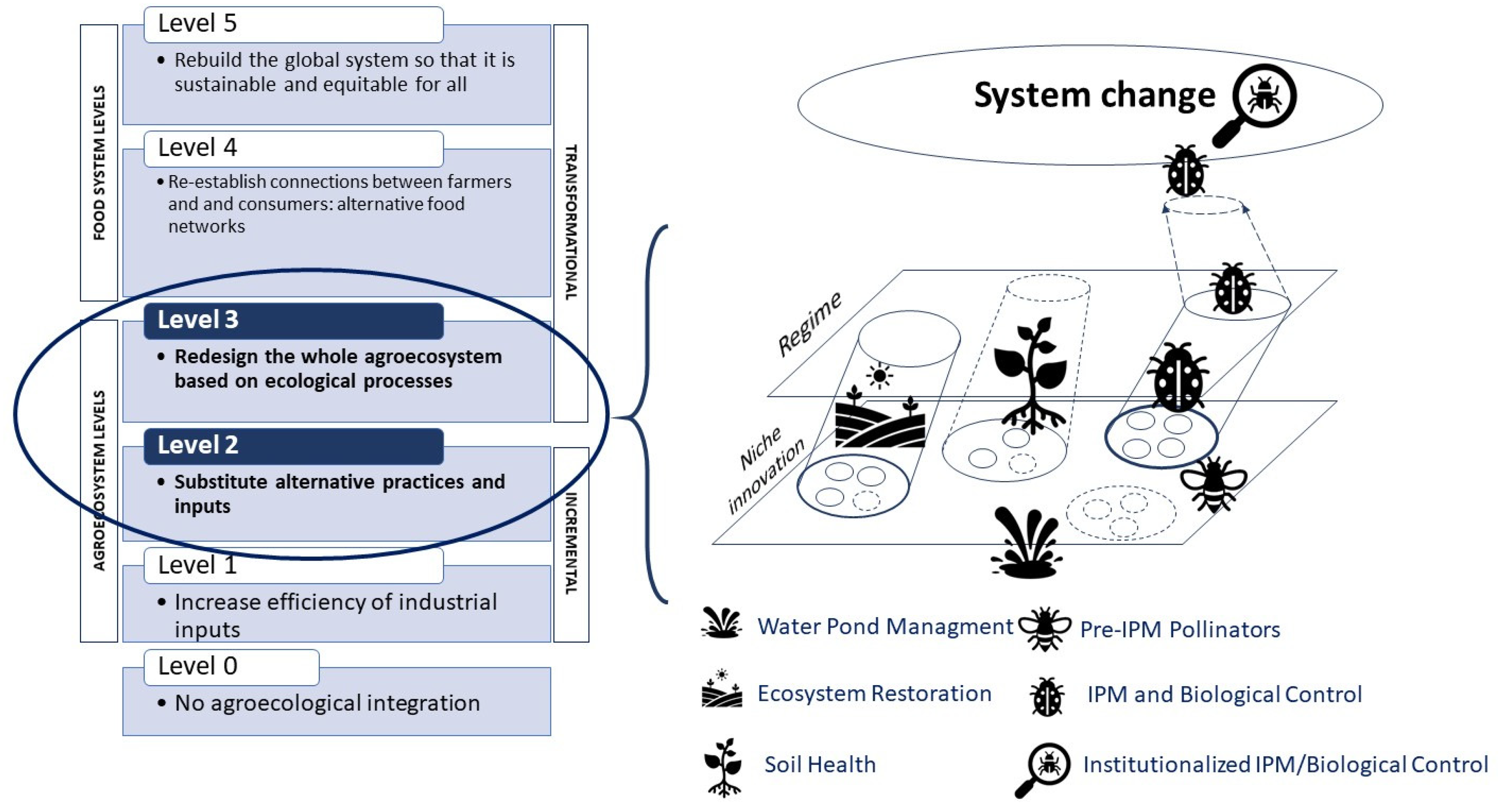
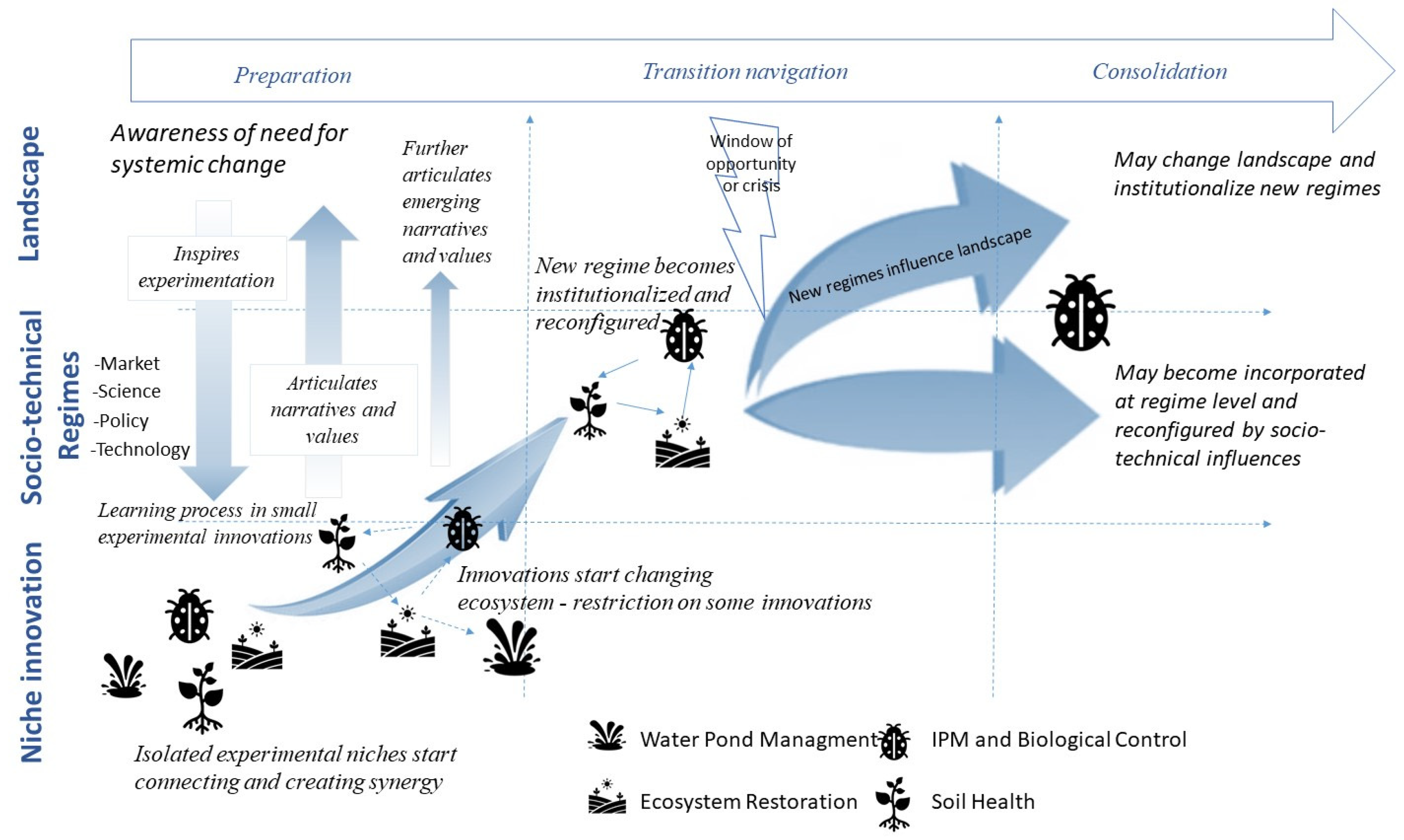
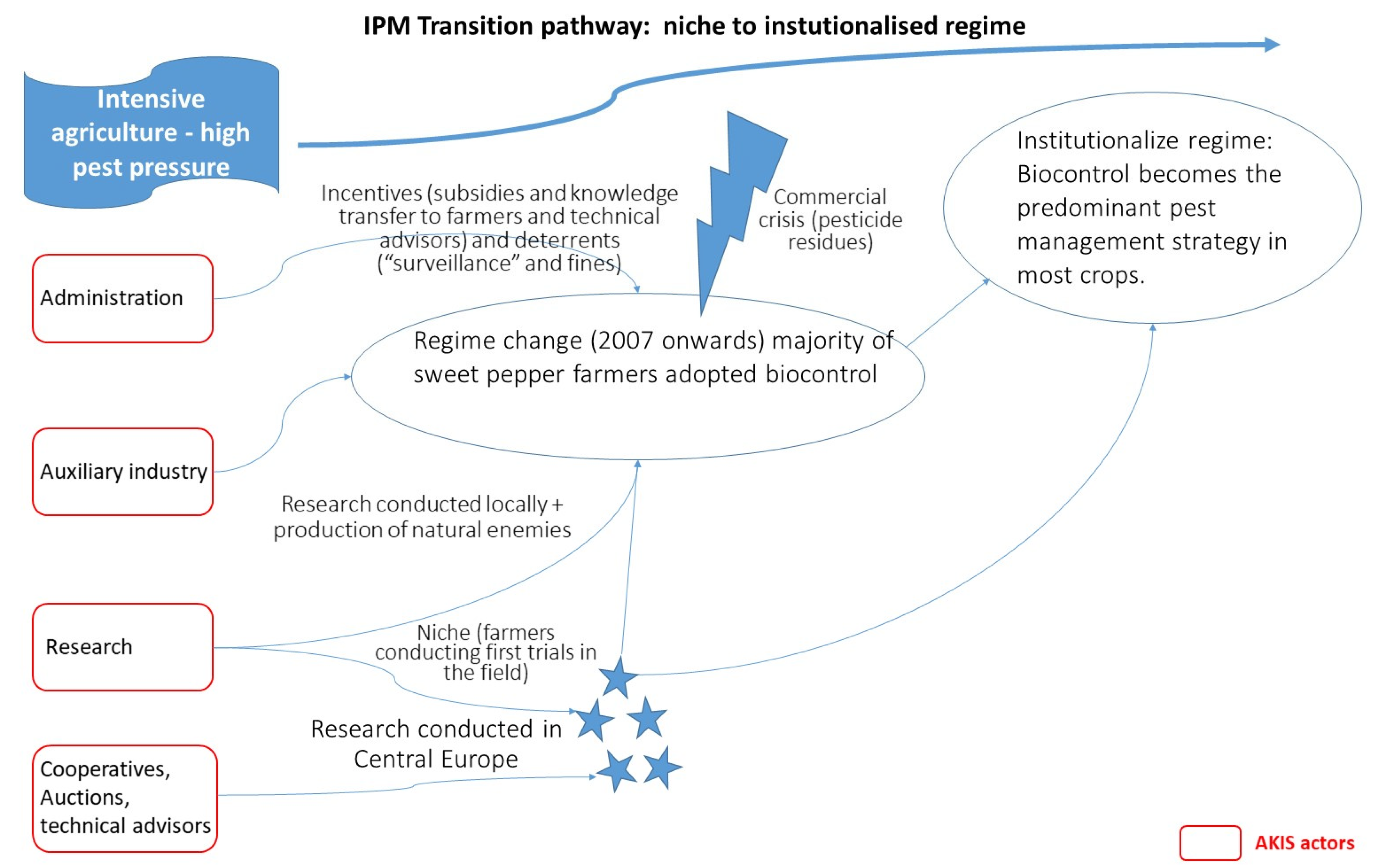
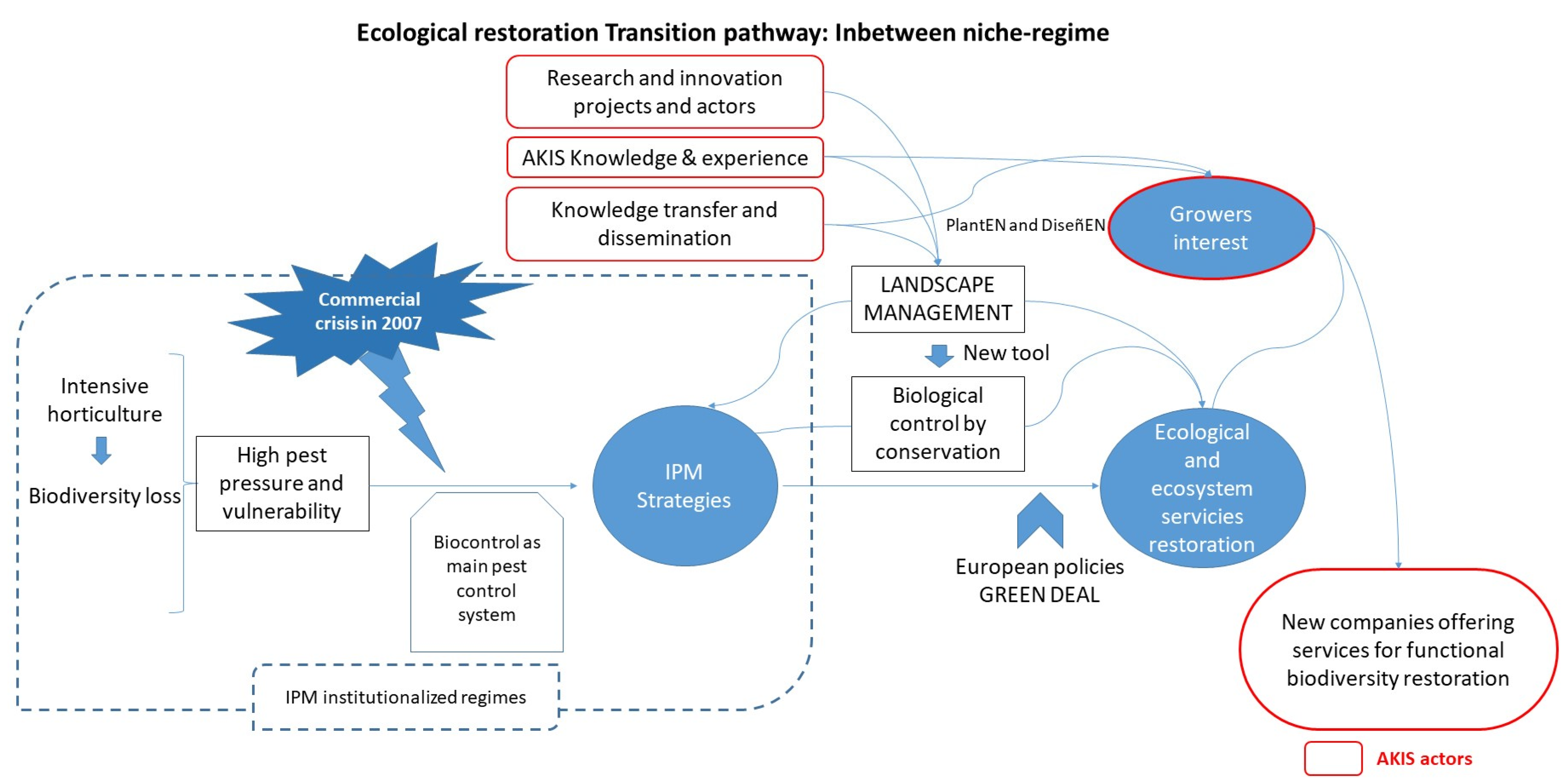
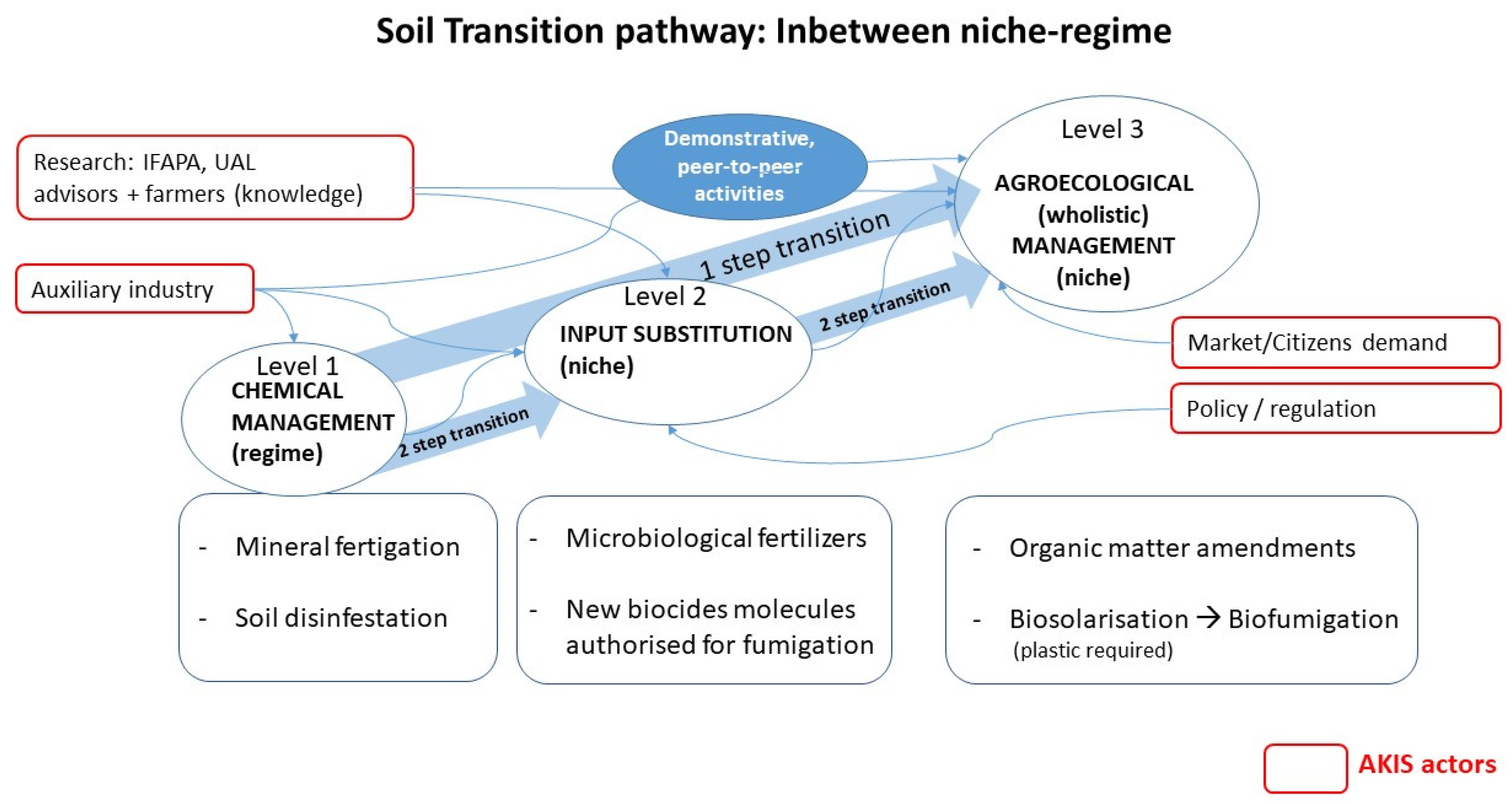
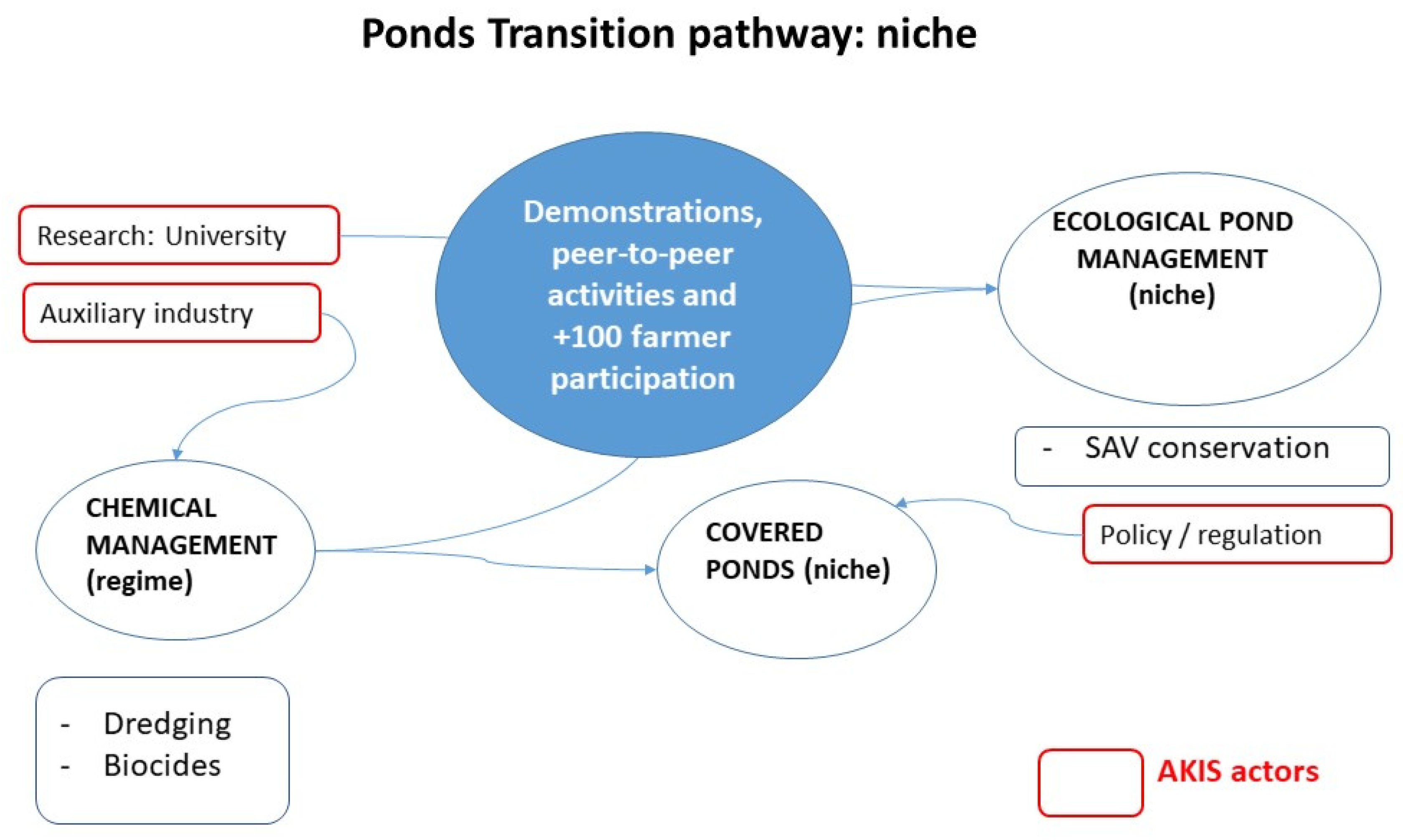
Publisher’s Note: MDPI stays neutral with regard to jurisdictional claims in published maps and institutional affiliations. |
© 2022 by the authors. Licensee MDPI, Basel, Switzerland. This article is an open access article distributed under the terms and conditions of the Creative Commons Attribution (CC BY) license (https://creativecommons.org/licenses/by/4.0/).
Share and Cite
Giagnocavo, C.; de Cara-García, M.; González, M.; Juan, M.; Marín-Guirao, J.I.; Mehrabi, S.; Rodríguez, E.; van der Blom, J.; Crisol-Martínez, E. Reconnecting Farmers with Nature through Agroecological Transitions: Interacting Niches and Experimentation and the Role of Agricultural Knowledge and Innovation Systems. Agriculture 2022, 12, 137. https://doi.org/10.3390/agriculture12020137
Giagnocavo C, de Cara-García M, González M, Juan M, Marín-Guirao JI, Mehrabi S, Rodríguez E, van der Blom J, Crisol-Martínez E. Reconnecting Farmers with Nature through Agroecological Transitions: Interacting Niches and Experimentation and the Role of Agricultural Knowledge and Innovation Systems. Agriculture. 2022; 12(2):137. https://doi.org/10.3390/agriculture12020137
Chicago/Turabian StyleGiagnocavo, Cynthia, Miguel de Cara-García, Mónica González, Melchor Juan, José Ignacio Marín-Guirao, Sepide Mehrabi, Estefanía Rodríguez, Jan van der Blom, and Eduardo Crisol-Martínez. 2022. "Reconnecting Farmers with Nature through Agroecological Transitions: Interacting Niches and Experimentation and the Role of Agricultural Knowledge and Innovation Systems" Agriculture 12, no. 2: 137. https://doi.org/10.3390/agriculture12020137
APA StyleGiagnocavo, C., de Cara-García, M., González, M., Juan, M., Marín-Guirao, J. I., Mehrabi, S., Rodríguez, E., van der Blom, J., & Crisol-Martínez, E. (2022). Reconnecting Farmers with Nature through Agroecological Transitions: Interacting Niches and Experimentation and the Role of Agricultural Knowledge and Innovation Systems. Agriculture, 12(2), 137. https://doi.org/10.3390/agriculture12020137









